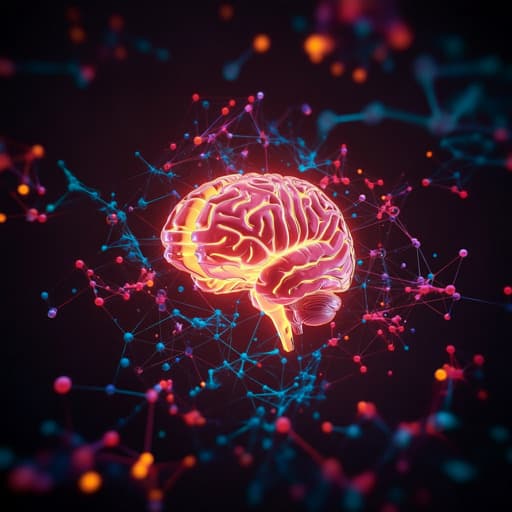
Education
SONIA: an immersive customizable virtual reality system for the education and exploration of brain networks
O. Hellum, C. Steele, et al.
Discover SONIA, a groundbreaking VR system revolutionizing the exploration and education of brain networks, developed by Owen Hellum, Christopher Steele, and Yiming Xiao. Experience an immersive learning environment that transcends traditional 2D methods, enabling you to customize your journey through the complex world of brain anatomy and connectivity.
~3 min • Beginner • English
Introduction
The brain’s complex 3D anatomy and dense interconnections are difficult to grasp using conventional 2D representations, which can obscure spatial geometry and relationships. Growing interest in functional and structural connectivity highlights the need for intuitive tools that convey pathways alongside associated neuroanatomy to enhance neuroscience education and exploration. Existing AR/VR solutions have focused largely on anatomical visualization with positive user feedback, while only a few systems attempt to visualize neural pathways and networks. Even fewer incorporate novel interaction paradigms or embed descriptive insights and guided learning module design.
This work introduces SONIA, a VR platform designed to educate users about neuroanatomy together with structural and functional brain networks. SONIA employs a multi-scale interaction paradigm (a large immersive brain paired with a manipulable small brain), progression-based learning with completion metrics, visual guidance, and audio narration. The system is customizable, supporting new datasets and narratives for various brain subsystems. Using the anxiety-related functional network as a case study, we evaluate usability and educational value, aiming to demonstrate SONIA’s potential to improve learning and exploration of brain connectivity.
Literature Review
Prior AR/VR applications have improved spatial understanding of neuroanatomy and aided surgical planning, leveraging mobile devices, VR headsets, and mixed reality platforms (e.g., Hololens). However, relatively few applications target neural pathways/connectivity visualization. NeuroCave offers web-based immersive exploration of connectomes; other workflows visualize tractography and functional connectivity in AR/VR. Recent efforts have built VR apps for educational visualization of sensory pathways. Despite these advances, most solutions emphasize visualization rather than novel interaction paradigms, and few embed descriptive narratives or structured learning modules for brain networks. This gap motivates SONIA’s design to combine immersive visualization, multi-scale interaction, and guided, customizable educational content.
Methodology
Content and virtual brain model: SONIA demonstrates the anxiety-relevant functional network summarized by Xie et al. (2021), focusing on six key structures: amygdala, hippocampus, striatum, medial prefrontal cortex (mPFC), hypothalamus, and bed nucleus of the stria terminalis (BNST). Five structures were extracted from the AAL116 atlas; BNST was manually segmented on the MNI152 template per Theiss et al. (2017). Discrete atlas labels were converted to mesh models (.fbx) for VR. The six key structures are highlighted; remaining atlas regions are semi-transparent to aid spatial reference. Lines (opaque for key structures, semi-transparent for others) indicate functional and anatomical connectivities.
VR environment and implementation: SONIA uses a multi-scale paradigm: users stand on a mission control platform within a magnified, immersive “large brain,” while a manipulable “small brain” (left hemisphere with anatomical meshes, right hemisphere with node-link graph) sits within reach for selection and navigation. Three floating panels present: (1) schematic diagrams of functional subsystems, (2) descriptive learning materials (names, descriptions, and connection details), and (3) progress/completion metrics. Unity 2021.3.2f1 with SteamVR was used. Hardware: HTC VIVE Pro Eye HMD; Razer Blade 15 (Intel Core i7, NVIDIA GeForce RTX 2070, 16 GB RAM). Performance was 45–50 FPS with no lag; one VR controller handled pointing and selection.
System workflow: Two phases guide learning using a single controller.
- Anatomical learning: Users select nodes (right hemisphere of small brain) with a short virtual stick; selected structures are highlighted in both small and large brains. The learning panel shows structure names and key points; the connectivity diagram progressively reveals nodes and edges as structures are visited.
- Connectivity learning: Users select a source structure on the small brain; the learning panel lists its outbound targets. Using a laser pointer, users choose a specific unidirectional connection to view descriptions. The selected connection is highlighted on both brain models and in the connectivity diagram. The progress panel tracks completion by subsystem. Color coding (unique colors per subsystem) is used consistently; white indicates current selection.
Customizability: SONIA loads alternative datasets through: 3D meshes (.fbx/.obj) of anatomy; CSV files for structure names/descriptions; and a connectivity matrix. Optional CSVs define subsystem names/descriptions and membership (structures and connections), plus optional meshes and connectivity for peripheral anatomies to enrich context. Users can adjust colors and textures in Unity. Layout of the connectivity diagram panel is user-defined for optimal clarity. Placing files in designated folders and setting editor variables enables rapid generation of new learning modules using subject-specific models or atlases (e.g., AAL116). The system demonstrated scalability with full atlas rendering without frame-rate loss.
User study and validation: Eleven participants (age 31.1±6.0; 4 female, 7 male), all at least somewhat familiar with neuroanatomy/connectivity (one VR novice), were recruited under Concordia University ethics approval. Participants completed a 20–30 minute tutorial with text-to-speech voice-over and on-screen text, covering interactions and subsystems. No motion sickness was reported; glasses were accommodated by the headset. Post-experience, participants completed a three-part questionnaire: (1) System Usability Scale (SUS; 10 items, 1–5 Likert; standard scoring; threshold of 68 indicates good usability); (2) additional ratings (1–5) on visual design (complexity, pleasantness, color-coding utility; plus an overall visual score), interaction design (navigational clarity), and learning experience (multi-scale aid to spatial understanding; perceived learning amount); and (3) open-ended feedback. One-sample t-tests compared SUS against 68 and individual sub-scores against neutral (3); p<0.05 was considered significant.
Key Findings
- SUS score: 79.8±11.6, significantly above 68 (p=0.007), indicating good usability. Most SUS sub-scores were positive (p<0.05), except perceived system complexity, which scored 2.3±1.2 (lower is less complex) and was not significantly different from neutral (p=0.07).
- Visual design: Overall visual score 3.9±0.5 (p=0.0001). Sub-scores: visual complexity 3.5±1.1 (p=0.14), graphic pleasantness 4.2±0.8 (p=0.0004), subsystem color-coding usefulness 4.0±0.9 (p=0.004).
- Interaction design: 3.6±0.9 (p=0.046), indicating effective communication of navigation through anatomies and connections.
- Learning experience: Multi-scale strategy rated neutral for enhancing anatomical understanding (3.1±1.1, p=0.80), but participants felt they learned a lot using the system (3.9±0.7, p=0.002).
- Qualitative feedback: Participants found the system useful and novel for representing data. Some felt mildly overwhelmed by dense UI text and placements, suggesting information overload in parts of the interface.
Discussion
The study shows that SONIA effectively addresses the need for immersive education on brain connectivity by combining 3D anatomical visualization with guided, descriptive exploration of neural pathways. High SUS scores and positive ratings for visual and interaction design suggest that the multi-component UI (small/large brains, panels, color coding) and interaction strategies (player agency, progress indicators) support usability and engagement. The neutral rating for the multi-scale strategy’s contribution to spatial understanding suggests that scale choices and limited movement within the large brain may temper perceived benefits, differing from prior geographic VR findings. Participants’ comments about UI complexity indicate a need to streamline textual content and layout to reduce cognitive load.
Overall, findings support SONIA’s value as a customizable, educational VR platform that integrates narratives about brain subsystems with interactive pathway exploration, potentially enriching neuroscience learning beyond traditional 2D materials. Design insights include the utility of consistent color coding, a manipulable node-based small brain for selection, and progress feedback to maintain motivation.
Conclusion
SONIA is a novel, customizable VR system that integrates immersive visualization, guided narratives of brain subsystems, and effective interaction strategies to support education and exploration of functional brain networks. A case study on anxiety-related circuitry and user evaluations demonstrated strong usability, appealing visual design, and perceived learning gains. As a first-of-its-kind prototype emphasizing customizable content and connectivity narratives, SONIA opens promising directions for medical learning in VR. Future work will expand content to additional networks, refine UI to reduce information overload, and further investigate multi-scale interaction designs and movement options to enhance spatial understanding.
Limitations
- Single case study (anxiety-related network) limits generalizability; content breadth was constrained by time.
- Small sample size (n=11) with participants already familiar with neuroanatomy; results may not generalize to novice learners.
- Some users perceived the UI as dense, with substantial on-screen text and potentially overwhelming information layout.
- Multi-scale representation did not significantly enhance perceived anatomical understanding; limited movement and specific scale choices may have reduced its impact.
- Affordances and interaction schemes were evaluated on a single hardware configuration; performance and ergonomics may differ on other systems.
Related Publications
Explore these studies to deepen your understanding of the subject.







